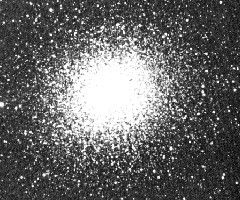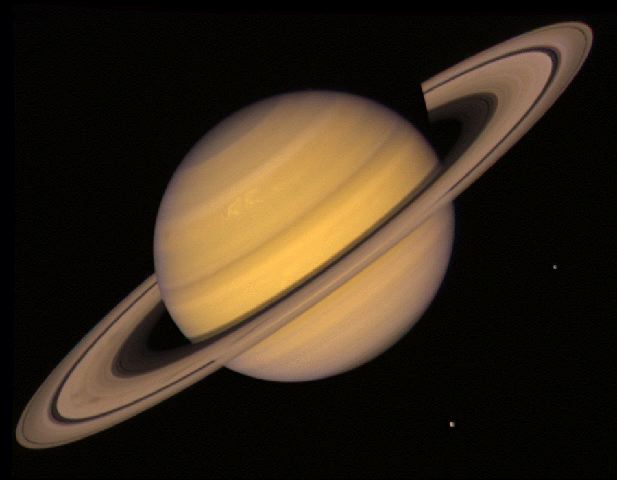| Observer: | Tom Campbell |
| Location: | College Station, Texas (Long: 101°56'W Lat: 33°47'N) |
| Telescope: | Zhumell 12" f/5 Dobsonian |
| Eyepieces: | 2" Explore Scientific 82° Erfle - 18mm 2" Explore Scientific 82° Erfle - 11mm |
| Seeing: | Somewhat Stable (5/10) |
| Transparency: | Partly cloudy |
| Temperature: | Upper 80s and humid. |
Observing this year has really been difficult. The skies have been cloudy most of the time, and we have had more rain already than we usually get in a year. And to top it off, along with the wet ground comes another annoyance - mosquitoes. I'm getting to the point now where I don't even mind offering myself as a buffet line as long as I can have a few relaxing minutes at the eyepiece.
The last four or five observing sessions have been completed while sharing the sky with clouds and poor seeing conditions. Despite my hopes that the recent rains would bring more stable conditions, I soon learned that tonight wasn't going to be any different.
Today was partly cloudy and hot, with temperatures reaching about 90°. By evening, it had cooled off slightly, but was still humid. The clouds were thinning, and I told my wife that if I could see more blue sky than clouds at sunset, I was going to do some observing.
Sunset came and there were still some clouds along the horizon in several directions, and one or two small ones overhead, but nothing major, so I began setting up. While waiting for it to get dark, I noticed how cool the thin 2-day-old Moon looked. I snapped a few pictures.
| CZ-2C R/B | Satellite | 9:35pm CDT | |
While I was waiting for the sky to darken a bit more, I was refamiliarizing myself with some of the late spring and early summer constellations. While looking around, some movement caught my eye. A bright satellite was passing overhead. I watched it for a minute or so until it began to dim. Later, I was able to determine that it was designated CZ-2C R/B, and was actually a Chinese rocket booster from a launch back in 2009. Cool! | |||
| |||
| M 13 | Hercules | Globular Cluster | 9:40pm CDT |
 |
The sky was pretty dark now. I didn't want to wait any longer and pointed at one of my favorite globular clusters. Using a barlowed 11mm eyepiece (345x), the globular filled the field. Hundreds of stars were visible. The overall shape was reminiscent of a face-on spiral galaxy, with many small arcs and dark areas that gave the vague appearance of spiral arms. |
||
| |||
| Jupiter | Leo | Planet | 9:45pm CDT |
 |
When I first set up my telescope tonight (shortly after sunset), I took a quick peek at Jupiter. Io was right on the edge of the giant planet with its shadow right in the middle of the NEB. However, the planet was bubbling and boiling in the atmospheric turbulence. I wasn't sure whether or not it was the sky conditions or just the fact that my telescope had not had time to properly acclimate to the outdoor temperature, so I decided to wait a bit longer and try again. By now, the moon has moved farther away and the shadow is about 2/3 of the way across Jupiter's disk. The other 3 moons were on the eastern side of the planet, forming a triangular pattern. Interestingly, a bit further away from the 3 moons was Chi Leonis, trying to disguise itself as a 5th Galilean moon, but it was a bit brighter than the others and gave itself away. On the planet itself, the equatorial bands looked nice, despite the atmospheric disturbances. The SEB had a narrow white cloud band splitting it in half. The NEB appeared a bit wider, with lots of swirls along the edges. Other cloud belts were present, but not nearly as obvious as I have seen them in the past. |
||
| |||
I decided to do a test of the sky conditions. I took aim at M65 and M66. I saw a faint wisp with averted vision as I slowly scanned the area. Was that NGC 3628? No, wait, there was another faint wisp near it. That was M65 and M66. I could barely make them out. Usually they were fairly bright and obvious. This did not bode well at all. At least there were planets to look at. |
|||
| |||
| Mars | Scorpius | Planet | 9:55pm CDT |
 |
Tonight's view of the red planet looked better than it did the other night. Again, my weapon of choice was a barlowed 11mm. The Northern Polar Cap was small, but visible. Nearby, Acidalia Planitia and Chryse Planitia appeared as a distinct dark green and gray against the planet's brownish-orange hue. Chryse Planitia is special in that this is where Viking I landed in 1976 and Pathfinder landed in 1997. Below the plains lay the mostly featureless Xanthe Terra region and south of this I could detect parts of Valles Marineris, a huge canyon (over 1850 miles long and 5 miles deep in places) that makes Earth's Grand Canyon look like a mere ditch. Very neat! |
||
| |||
| Saturn | Ophiuchus | Planet | 10:15pm CDT |
 |
Although barely above the roof of my house, I had yet to see Saturn this year and wanted to take a peek. Clouds were beginning to move into that part of the sky, so I couldn't wait any longer. Every time I look at Saturn is like the first time. At 345x, the banding on the planet was obvious, showing off its hues of browns, yellows and grays. Even without the rings, this would be a favorite. But oh, those rings! The A and B rings were obvious, of course, as was the Cassini Division. The deteriorating sky conditions meant that I wasn't able to clearly make out the Encke Gap, however. The Crepe Ring (C Ring) was visible against the planet and sometimes out at the sides, but I couldn't follow it the entire distance. Definitely not my best view of the planet, but it was still good and I will get other chances in the future. |
||
| |||
Looking around at the sky again, I saw the clouds continuing to advance. Since I was in Scorpius already, I took aim at M4. Nothing. Huh? I've seen it looking nice in my 60mm refractor before, but tonight, even the Biggie Z couldn't pull it out of the murky atmosphere. I even consulted a star chart to make sure I was remembering where it should be. Yep, I was aiming at the right spot in the sky, but nothing was there. Time to give up.
Before packing things away, I decided to have my wife and nephew come out and take a peek at the planets. I slipped my 18mm eyepiece into the barlow (211x). This would still give them a decent view of the surface features but keep the planet in the eyepiece longer.
I swung the scope back around to Jupiter, Mars, and Saturn again and let them both take a long look. I asked them which one they liked the best. My nephew thought Saturn's rings were the coolest. My wife, who has seen Saturn several times before, thought that seeing surface features on Mars was the coolest. They are both right!